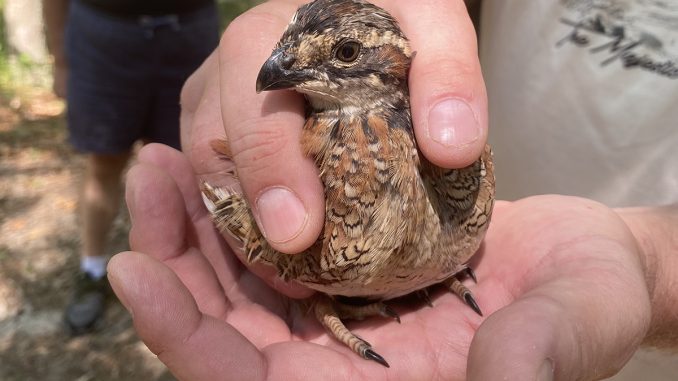
The sun cast dappled shade through the leaves of Brookhaven State Park as a record crowd of more than 40 people gathered to release the first batch of bobwhite quail of the summer. These birds are part of the bobwhite quail release program at the Center for Environmental Education and Discovery in Brookhaven. Beginning in April, more than 1,700 eggs were incubated by 41 schools, libraries and individual families. From those eggs, around 1,000 chicks were raised in outdoor pens in preparation for their release.
This program is the brainchild of biologist Eric Powers, program and site director at CEED. While working at Caleb State Park in Smithtown, he made it his personal mission to learn why the tick population was exploding on Long Island. Along with a group of other scientists, Mr. Powers conducted what’s known as a “bioblitz,” which is a survey of species in a given area over a 24-hour period. He then compared this to the list of species from when the park was founded in 1969.
“During my data analysis, I was trying to figure out, what is the one thing that’s missing that would be eating ticks? And I narrowed it down to bobwhite quail. And that’s when I was like, ‘okay, but now what do we do? How do we bring back bobwhite quail?’ ” Mr. Powers said.
At the same time, Mr. Powers was frequently fielding calls from teachers asking for his help in rehoming chicks and ducklings from class hatching projects. Then he had what he describes as his lightbulb moment. “I was like, ‘oh, wait a minute, if you switch to bobwhite quail, that’s a native bird. I can get a permit from the [Department of Environmental Conservation] to raise and release these back into the wild.’ I got that and started doing it, and that kind of launched the project.”
Mr. Powers brought the project to CEED five years ago. Past studies have shown a significant reduction in tick numbers after the quail are released. However, in order to establish a self-sustaining population, many more birds are needed.
According to quailforever.org, quail rarely die of old age. In fact, the average quail’s lifespan is less than 1 year. On average, 70 to 80% of the nation’s quail population is lost each year; this high mortality rate is off-set by large broods. One common misconception is that human hunting is the biggest threat to quail. However, the two biggest factors in their decline on Long Island are habitat loss and domestic cats, both feral and indoor/outdoor pets.
Mr. Powers points out that keeping cats indoors is a huge boon to many animals, not just quail.
“When Europeans first came here, they didn’t have fences. The cattle would have just roamed in the salt marshes. Their horses would have just roamed in pastures. Then conflict happened, because your cattle got mixed in with my cattle and things like that. So they changed their paradigm, and they started to put up fences and corrals and kept them separated. Roaming dogs would form packs that would sometimes attack people, and our culture adapted again, and you have to keep your dog confined to your property. And our culture really needs to adapt one more time to save our ecology,” he said.
A similar “Bring Back Bobwhite” program has been running on Shelter Island with birds hatched in Pennsylvania released at Silver Beach Bird Sanctuary and several other spots around the island last summer. There is currently a higher demand regionally for quail than there are birds to release.
There are opportunities to get involved at every step of the process. After obtaining the DEC permit, clubs, classrooms and individuals can hatch eggs with an incubator and brooder set up. When this stage is complete, usually in about three weeks, the birds go to outdoor pens and need daily care, usually at sites managed by the quail program. There is currently an Eagle Scout from Centereachworking with the CEED program to design collapsible pens that can house 250 birds. If they are successful, these pens will be available for volunteers to use at their own property.
Besides raising chicks, creating quail-friendly habitats by eliminating grass and planting native plants helps multiple species and advocating for local and state governments to do the same establishes ‘quail corridors’ that combat habitat loss.
“There’s so many parks and wonderful park managers out there, but they don’t know about the plight of the bobwhite quail,” Mr. Powers said. “So whenever anybody sees a field in a park that’s been kind of left to weeds, why not reach out to the organization that manages it and suggest they replant it with a quail-friendly mix of plants; that’s directly sowing quail habitat. If we get enough of these microparks across Long Island, maybe we could reestablish a population somewhere.”
Tracking the quail after release is challenging. Leg bands and wing clips have both proven fatal in the past and don’t allow for real-time reporting on the movements and habits of the birds. More advanced equipment is expensive, and grants that would allay that cost want supporting data.
“Everybody that I’ve applied for wants data on success, rates of survival, and so I’m caught in a catch-22. I can’t get the funding without the data, and I can’t get the data without the funding. So maybe there’s somebody out there that’s willing to fund it for a year so that we could start getting data and apply for next level funding.”
To hatch a brood of quail or volunteer, contact CEED at 631-803-6780 or [email protected].

